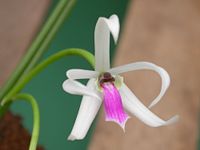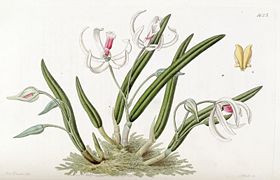Leptotes (orchid): Difference between revisions
imported>Dalton Holland Baptista No edit summary |
imported>Dalton Holland Baptista |
||
| Line 54: | Line 54: | ||
{{Image|Leptotes bicolor Edwards.jpg|right|280px|Original illustration published by John Lindley when he described the genus ''Leptotes'', in 1833.}}In April of 1833, it blossomed in the greenhouse of Mrs. Arnold Harrison, English collector of orchids homaged in diverse descriptions of noted species such as ''[[Bifrenaria harrisoniae]]'' and ''[[Cattleya harrisoniana]]'' an unknown species that she had received from [[Serra dos Órgãos]] mountains, in Brazil. Little time later, Mrs. Harrison sent a drawing and cut of this plant to the botanist [[John Lindley]], who verified to be a new species. In its description, dated of the same year, Lindley suggests the name of ''Leptotes'', of [[Greek language |Greek]], ''mild'', ''delicate'', in reference to the appearance of the flowers of this plant. He affirms that ''Leptotes'' is similar and close to ''[[Tetramicra]]'' from which it is distinguished by the structures of the pollinarium and by the lateral lobes of the lip of its flowers, much smaller; and because they have no calcar attached to the [[ovarium]]. He also explains that from ''Brassavola'' it can be differentiated by the pollinia and trilobed lip. Then Lindley describes its [[type-species]], ''[[Leptotes bicolor]]''.<ref><span style="font-variant:small-caps;">Lindley, John</span>: ''Leptotes bicolor'' in '''Edward's Botanical Register Vol.19''', t.1625. James Ridgway & Sons Ed. London, 1833. [http://www.botanicus.org/item/31753002748314 Published on internet.]</ref> | {{Image|Leptotes bicolor Edwards.jpg|right|280px|Original illustration published by John Lindley when he described the genus ''Leptotes'', in 1833.}}In April of 1833, it blossomed in the greenhouse of Mrs. Arnold Harrison, English collector of orchids homaged in diverse descriptions of noted species such as ''[[Bifrenaria harrisoniae]]'' and ''[[Cattleya harrisoniana]]'' an unknown species that she had received from [[Serra dos Órgãos]] mountains, in Brazil. Little time later, Mrs. Harrison sent a drawing and cut of this plant to the botanist [[John Lindley]], who verified to be a new species. In its description, dated of the same year, Lindley suggests the name of ''Leptotes'', of [[Greek language |Greek]], ''mild'', ''delicate'', in reference to the appearance of the flowers of this plant. He affirms that ''Leptotes'' is similar and close to ''[[Tetramicra]]'' from which it is distinguished by the structures of the pollinarium and by the lateral lobes of the lip of its flowers, much smaller; and because they have no calcar attached to the [[ovarium]]. He also explains that from ''Brassavola'' it can be differentiated by the pollinia and trilobed lip. Then Lindley describes its [[type-species]], ''[[Leptotes bicolor]]''.<ref><span style="font-variant:small-caps;">Lindley, John</span>: ''Leptotes bicolor'' in '''Edward's Botanical Register Vol.19''', t.1625. James Ridgway & Sons Ed. London, 1833. [http://www.botanicus.org/item/31753002748314 Published on internet.]</ref> | ||
In 1838, Lindley received two similar but slightly different plants, collected in [[Macaé de Cima]] and [[Ilha Grande]], in [[Rio de Janeiro]]. Considering them different of the previously described species, because the lateral lobes of lip were slightly serrated, because their flowers were bigger, and also because they occasionally had a second leaf by pseudobulb, proposed a new species with the name of ''Leptotes serrulata''.<ref><span style="font-variant:small-caps;">Lindley, John</span>: ''Leptotes serrulata'' in '''Sertum orchidaceum''', t.11. James Ridgway & Sons Ed. London, 1838. [http://www.botanicus.org/item/31753002748314 Published on internet.]</ref> Five years later, the German Count [[Johann Centurius von Hoffmannsegg]], considering that the leaves of one plant he cultivated presented a different green-bluish tone, described the plant calling it ''L. glaucophylla''.<ref><span style="font-variant:small-caps;">Hoffmannsegg, Johann Centurius von</span>: ''Leptotes glaucophylla'' in '''Botanische Zeitung Vol.1''', p. 833. Berlin, 1843.</ref> When reviewing all the known species ''Leptotes'' at the time, in 1990, [[Carl Leslie Withner]], opposing diverse previous taxonomists, who already had noticed the great similarity of all the species described so far, goes yet | In 1838, Lindley received two similar but slightly different plants, collected in [[Macaé de Cima]] and [[Ilha Grande]], in [[Rio de Janeiro]]. Considering them different of the previously described species, because the lateral lobes of lip were slightly serrated, because their flowers were bigger, and also because they occasionally had a second leaf by pseudobulb, proposed a new species with the name of ''Leptotes serrulata''.<ref><span style="font-variant:small-caps;">Lindley, John</span>: ''Leptotes serrulata'' in '''Sertum orchidaceum''', t.11. James Ridgway & Sons Ed. London, 1838. [http://www.botanicus.org/item/31753002748314 Published on internet.]</ref> Five years later, the German Count [[Johann Centurius von Hoffmannsegg]], considering that the leaves of one plant he cultivated presented a different green-bluish tone, described the plant calling it ''L. glaucophylla''.<ref><span style="font-variant:small-caps;">Hoffmannsegg, Johann Centurius von</span>: ''Leptotes glaucophylla'' in '''Botanische Zeitung Vol.1''', p. 833. Berlin, 1843.</ref> When reviewing all the known species ''Leptotes'' at the time, in 1990, [[Carl Leslie Withner]], opposing diverse previous taxonomists, who already had noticed the great similarity of all the species described so far, goes yet further and, based on the drawings published by Lindley, finds additional differences between ''L. bicolor'' and ''L. serrulata'', affirming that second always bears many more flowers, with up to seven flowers for inflorescence, which is also much longer. <ref name="W"><span style="font-variant:small-caps;">Withner, Carl Leslie</span>: '''The Cattleyas and Their Relatives, Vol. 3''', p.96. Timber Press, Oregon. ISBN 0881922692</ref> Today we know that both descriptions are of slight variations of ''L. bicolor'', that, for its ample dispersion and multiplicity of populations, is a much variable plant.<ref name="K"><span style="font-variant:small-caps;">Govaerts, Rafaël ''et al''</span>: '''World Checklist of Orchidaceae'''. The Board of Trustees of the Royal Botanic Gardens, Kew. {{link|en|2=http://www.kew.org/wcsp|3=Published on Internet}} (Access in January 2009).</ref> | ||
In 1865, [[Heinrich Gustav Reichenbach]], received, from some unknown locality in Brazil, the second described species to be accepted today, a plant much different from ''Leptotes bicolor'', because of its fewer and smaller rounded flowers, with wide open pale yellowish segments. He published it as ''L. tenuis''.<ref><span style="font-variant:small-caps;">Reichenbach, Heinrich Gustav</span>: ''Leptotes tenuis'' in '''Hamburger Garten Blumenzeitung Vol.21''', pp. 296. Hamburg, 1865.</ref> Twelve years later, the third species, ''Leptotes unicolor'', was described by Brazilian Botanist [[João Barbosa Rodrigues]]. According to the author, it was a much perfumed little species which he found some colonies with hundreds of plants living epiphyticaly along the banks of rivers [[Rio Dourado|Dourado]] and [[Rio Sapucai|Sapucai]], nearby the city of [[Alfenas]], in [[Minas Gerais]].<ref><span style="font-variant:small-caps;">Barbosa Rodrigues, João</span>: ''Leptotes unicolor'' in '''Genera et species orchidacearum novarum''' Vol.1, p.74. 1877. [http://www.botanicus.org/title/b12207019 Published on Internet, in French and Latin.]</ref> In 1881, Barbosa Rodrigues found another plant with longer leaves and slight diferences on floral structure, in [[Joinville]], a city that at the time belonged to [[Paraná]] State, but today is located in [[Santa Catarina]] which didn't exist then, and described it as ''L. paranaensis''.<ref><span style="font-variant:small-caps;">Barbosa Rodrigues, João</span>: ''Leptotes paranaensis'' in '''Genera et species orchidacearum novarum''' Vol.2, pp.163. 1881. [http://www.botanicus.org/title/b12207019 Published on Internet, in French and Latin.]</ref> Today this species is considered to be just a variation of ''L. unicolor'' he described four years earlier.<ref name="OB"><span style="font-variant:small-caps">Pabst, Guido & Dungs, Fritz </span>: '''Orchidaceae Brasilienses vol. 1''' p. 148, Brucke-Verlag Kurt Schmersow, Hildesheim, 1975. ISBN 3871050106 </ref> | |||
<!-- | <!-- | ||
Oito anos mais tarde, [[Robert Allen Rolfe]] recebeu, também de localidade ignorada do Brasil, uma planta similar à ''Leptotes tenuis'' que Reichenbach descrevera em 1865, porém com folhas bem mais grossas e curtas, descreveu-a com o nome de ''L. minuta''.<ref><span style="font-variant:small-caps;">Rolfe, Robert Allen</span>: ''Leptotes minuta'' em '''Gardeners' Chronicle Vol.1889-2''': p. 323. London, 1889.</ref> Em sua revisão das plantas do Brasil, publicada em 1903, [[Célestin Alfred Cogniaux]], ignorando a variabilidade a que estavam sujeitas as espécies de ''Leptotes'', tanto pela existência de diversas populações isoladas, bem como por diferenças no comprimento e espessura das folhas devido a variações decorrentes de maior ou menor exposição à luz, aceitou como boa esta espécie que sabe-se ser uma variação da ''L. tenuis'', bem como a maioria das outras até então descritas.<ref><span style="font-variant:small-caps;">Cogniaux, Célestin Alfred</span>: ''Leptotes'' em '''Flora Brasiliensis Vol.3 Part.6''': pp. 254-259. K.F.P. von Martius Ed., 1903. [http://florabrasiliensis.cria.org.br/search?taxon_id=1511 Publicado na Internet, em latim.]</ref> | Oito anos mais tarde, [[Robert Allen Rolfe]] recebeu, também de localidade ignorada do Brasil, uma planta similar à ''Leptotes tenuis'' que Reichenbach descrevera em 1865, porém com folhas bem mais grossas e curtas, descreveu-a com o nome de ''L. minuta''.<ref><span style="font-variant:small-caps;">Rolfe, Robert Allen</span>: ''Leptotes minuta'' em '''Gardeners' Chronicle Vol.1889-2''': p. 323. London, 1889.</ref> Em sua revisão das plantas do Brasil, publicada em 1903, [[Célestin Alfred Cogniaux]], ignorando a variabilidade a que estavam sujeitas as espécies de ''Leptotes'', tanto pela existência de diversas populações isoladas, bem como por diferenças no comprimento e espessura das folhas devido a variações decorrentes de maior ou menor exposição à luz, aceitou como boa esta espécie que sabe-se ser uma variação da ''L. tenuis'', bem como a maioria das outras até então descritas.<ref><span style="font-variant:small-caps;">Cogniaux, Célestin Alfred</span>: ''Leptotes'' em '''Flora Brasiliensis Vol.3 Part.6''': pp. 254-259. K.F.P. von Martius Ed., 1903. [http://florabrasiliensis.cria.org.br/search?taxon_id=1511 Publicado na Internet, em latim.]</ref> | ||
Revision as of 06:41, 25 February 2009
| Leptotes | ||||||||||||||||||||
|---|---|---|---|---|---|---|---|---|---|---|---|---|---|---|---|---|---|---|---|---|
 Leptotes bicolor
| ||||||||||||||||||||
| Scientific classification | ||||||||||||||||||||
| ||||||||||||||||||||
| Type species | ||||||||||||||||||||
| Leptotes bicolor Lindl. 1833 | ||||||||||||||||||||
| Species | ||||||||||||||||||||
| ||||||||||||||||||||
| Synonym | ||||||||||||||||||||
|
None |
Leptotes is a genus of orchids formed by nine small species of Brazil which exist in the dry jungles of South and Southeast, and also in Paraguay or Argentina. They are small epiphytic plants of caespitific growth, that sometimes resemble little Brassavola, as they share same type of thin terete leaves, however, they are more closely related to Loefgrenianthus.
Some species of Leptotes are widely cultivaded and form showy displays when completely in bloom, yet the majority of species are not commonly found under cultivation, some are rare or even almost completely unknown. Five species have only been described after year 2000. They are not included among the orchids easiest to grow. Beside being cultivated for their ornamental value, there are records of eventual uses of the flowers and fruits of Leptotes bicolor as milk, ice cream, tea and candies aromatizers instead of Vanilla.[1]
Distribution
The species of Leptotes are originary from Atlantic Forest of Brazil, two species also found in other countries, L. unicolor in Argentina, and L. bicolor in Paraguay, always living epiphyticaly. Three species show high degree of endemism in the South of Bahia State, these do not exist in any other places. The distribution of one species is only an assumption. The states southeastern of Brazil are the ones that present the highest level of species occurrence, however, the extreme limits of distribution range from the Serra da Jibóia chain of mountains, in Bahia, to the North of Rio Grande do Sul State.[2]
The species of the group of wide open flowers, as Leptotes tenuis and L. pauloensis, are more frequent in cloud mountain forests. L. bicolor is the species most spread out and adaptated both to cloud mountanin forests and to the dryer woods of plateaus above of Serra do Mar chain of Mountains. Leptotes unicolor is a plant from coller areas, above 700 meters of altitude, frequently found growing on Araucaria and Podocarpus trees in the Southern areas of Brazil.[2]
Description
The species assigned to the genus Leptotes are plants of short rhizome, of cylindrical section, with very small pseudobulbs that almost imperceptibly prolongate in one, rarely two, short or long, erect or hanging, terete fleishy leaves, of dark green or purple colors, frequently presenting wrinkly surfaces, with a more or less deeper ridge in the face. The inflorescence is apical, generally short, and grows from the apex of the pseudobulb, without a protecting spathe, bearing one to seven flowers, however two or three are more common. The flowers are relatively large when are compared to the plant dimensions, normally partially bent, in some species forming groups of very showy aspect.[2]
Their flowers generally are of different shades of pink, greenish or white, with lip spotted of pale yellow, light purple or lilac, perfumed, which last from ten to twenty days.[3] The petals and sepals are similar, elongated, of the same color, the petals slightly narrower than the sepals. The lip is located along the column, trilobated, with small lateral lobes, raised aside of the column, however never involving it, or flat; the intermediate lobe is much bigger than the lateral ones, showing lanceolated or obovated format, occasionally fleishy, flat or bending backwards; in some species with denticulated edges, in other with smooth ones; rarely calli are present and it has claws wich hold it attached to the sides of the column. This is short, thick and erect, normally greenish, biauriculated, and bears six pollinia of different sizes, two larger in the center and four smaller in two pairs hold by a short caudicle, in an arrangement without similar among the orchids. Their fruits are rounded, succulent and perfumed as the ones of Vanilla.[4]
Leptotes pollination has never been observed and the assumptions about its agents are different, Cássio van den Berg assumes that, because of the colors and morphology of its flowers, they might be pollinated by bees,[2] while other orchidologists indicate the possibility of hummingbird pollination.[3]
Taxonomic notes
In April of 1833, it blossomed in the greenhouse of Mrs. Arnold Harrison, English collector of orchids homaged in diverse descriptions of noted species such as Bifrenaria harrisoniae and Cattleya harrisoniana an unknown species that she had received from Serra dos Órgãos mountains, in Brazil. Little time later, Mrs. Harrison sent a drawing and cut of this plant to the botanist John Lindley, who verified to be a new species. In its description, dated of the same year, Lindley suggests the name of Leptotes, of Greek, mild, delicate, in reference to the appearance of the flowers of this plant. He affirms that Leptotes is similar and close to Tetramicra from which it is distinguished by the structures of the pollinarium and by the lateral lobes of the lip of its flowers, much smaller; and because they have no calcar attached to the ovarium. He also explains that from Brassavola it can be differentiated by the pollinia and trilobed lip. Then Lindley describes its type-species, Leptotes bicolor.[5]
In 1838, Lindley received two similar but slightly different plants, collected in Macaé de Cima and Ilha Grande, in Rio de Janeiro. Considering them different of the previously described species, because the lateral lobes of lip were slightly serrated, because their flowers were bigger, and also because they occasionally had a second leaf by pseudobulb, proposed a new species with the name of Leptotes serrulata.[6] Five years later, the German Count Johann Centurius von Hoffmannsegg, considering that the leaves of one plant he cultivated presented a different green-bluish tone, described the plant calling it L. glaucophylla.[7] When reviewing all the known species Leptotes at the time, in 1990, Carl Leslie Withner, opposing diverse previous taxonomists, who already had noticed the great similarity of all the species described so far, goes yet further and, based on the drawings published by Lindley, finds additional differences between L. bicolor and L. serrulata, affirming that second always bears many more flowers, with up to seven flowers for inflorescence, which is also much longer. [8] Today we know that both descriptions are of slight variations of L. bicolor, that, for its ample dispersion and multiplicity of populations, is a much variable plant.[9]
In 1865, Heinrich Gustav Reichenbach, received, from some unknown locality in Brazil, the second described species to be accepted today, a plant much different from Leptotes bicolor, because of its fewer and smaller rounded flowers, with wide open pale yellowish segments. He published it as L. tenuis.[10] Twelve years later, the third species, Leptotes unicolor, was described by Brazilian Botanist João Barbosa Rodrigues. According to the author, it was a much perfumed little species which he found some colonies with hundreds of plants living epiphyticaly along the banks of rivers Dourado and Sapucai, nearby the city of Alfenas, in Minas Gerais.[11] In 1881, Barbosa Rodrigues found another plant with longer leaves and slight diferences on floral structure, in Joinville, a city that at the time belonged to Paraná State, but today is located in Santa Catarina which didn't exist then, and described it as L. paranaensis.[12] Today this species is considered to be just a variation of L. unicolor he described four years earlier.[13]
References
- ↑ Lawler, L.J.: Ethnobotany of the Orchidaceae in Orchid biology: reviews and perspectives, Vol.3. J. Arditti Ed., Cornell University Press, Ithaca, New York, 1984.
- ↑ 2.0 2.1 2.2 2.3 Van den Berg, Cássio: Leptotes in Genera Orchidacearum Vol.4, pp. 271-3. Oxford University Press, 2006. ISBN 9780198507123.
- ↑ 3.0 3.1 Miller, David; Richard Warren; Izabel Moura Miller & Helmut Seehawer: Serra dos Órgãos sua história e suas orquídeas, p. 240. Rio de Janeiro, 2006.
- ↑ Withner, Carl Leslie: The Cattleyas and Their Relatives, Vol. 3, pp.94-95. Timber Press, Oregon. ISBN 0881922692
- ↑ Lindley, John: Leptotes bicolor in Edward's Botanical Register Vol.19, t.1625. James Ridgway & Sons Ed. London, 1833. Published on internet.
- ↑ Lindley, John: Leptotes serrulata in Sertum orchidaceum, t.11. James Ridgway & Sons Ed. London, 1838. Published on internet.
- ↑ Hoffmannsegg, Johann Centurius von: Leptotes glaucophylla in Botanische Zeitung Vol.1, p. 833. Berlin, 1843.
- ↑ Withner, Carl Leslie: The Cattleyas and Their Relatives, Vol. 3, p.96. Timber Press, Oregon. ISBN 0881922692
- ↑ Govaerts, Rafaël et al: World Checklist of Orchidaceae. The Board of Trustees of the Royal Botanic Gardens, Kew. [en http://www.kew.org/wcsp] (Access in January 2009).
- ↑ Reichenbach, Heinrich Gustav: Leptotes tenuis in Hamburger Garten Blumenzeitung Vol.21, pp. 296. Hamburg, 1865.
- ↑ Barbosa Rodrigues, João: Leptotes unicolor in Genera et species orchidacearum novarum Vol.1, p.74. 1877. Published on Internet, in French and Latin.
- ↑ Barbosa Rodrigues, João: Leptotes paranaensis in Genera et species orchidacearum novarum Vol.2, pp.163. 1881. Published on Internet, in French and Latin.
- ↑ Pabst, Guido & Dungs, Fritz : Orchidaceae Brasilienses vol. 1 p. 148, Brucke-Verlag Kurt Schmersow, Hildesheim, 1975. ISBN 3871050106


